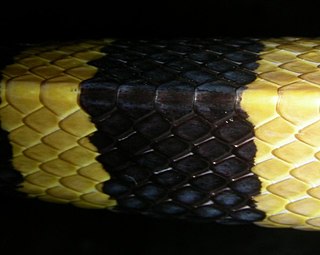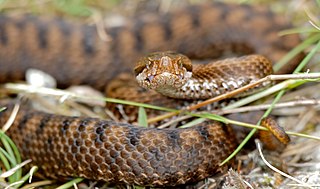| Vipera ammodytes montandoni | |
|---|---|
| Scientific classification | |
| Kingdom: | Animalia |
| Phylum: | Chordata |
| Clade: | Tetrapodomorpha |
| Class: | Reptilia |
| Order: | Squamata |
| Suborder: | Serpentes |
| Family: | Viperidae |
| Genus: | Vipera |
| Species: | V. ammodytes |
| Subspecies: | V. a. montandoni |
| Trinomial name | |
| Vipera ammodytes montandoni Boulenger, 1904 | |
| Synonyms | |
- Common names: transdanubian sand viper. [2]
Vipera ammodytes montandoni is a venomous viper subspecies [3] endemic to Bulgaria and southern Romania. [4]
Venomous snakes are species of the suborder Serpentes that are capable of producing venom, which they use for killing prey, for defense, and to assist with digestion of their prey. The venom is typically delivered by injection using hollow or grooved fangs, although some venomous snakes lack well-developed fangs. Common venomous snakes include the families Elapidae, Viperidae, Atractaspididae, and some of the Colubridae. The toxicity of venom is mainly indicated by murine LD50, while multiple factors are considered to judge the potential danger to humans. Other important factors for risk assessment include the likelihood that a snake will bite, the quantity of venom delivered with the bite, the efficiency of the delivery mechanism, and the location of a bite on the body of the victim. Snake venom may have both neurotoxic and hemotoxic properties.

The Viperinae, or viperines, are a subfamily of venomous vipers endemic to Europe, Asia and Africa. They are distinguished by their lack of the heat-sensing pit organs that characterize their sister group, the subfamily Crotalinae. Currently, 12 genera and 66 species are recognized. Most are tropical and subtropical, although one species, Vipera berus, even occurs within the Arctic Circle.

In biological classification, the term subspecies refers to a unity of populations of a species living in a subdivision of the species' global range and varies from other populations of the same species by morphological characteristics. A subspecies cannot be recognized independently. A species is either recognized as having no subspecies at all or at least two, including any that are extinct. The term is abbreviated subsp. in botany and bacteriology, or ssp. in zoology. The plural is the same as the singular: subspecies.


















